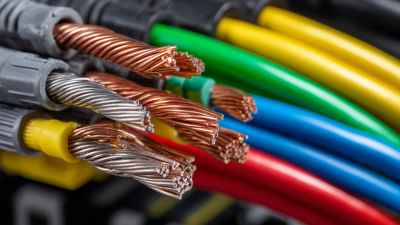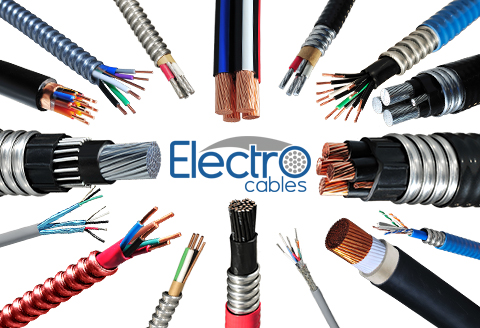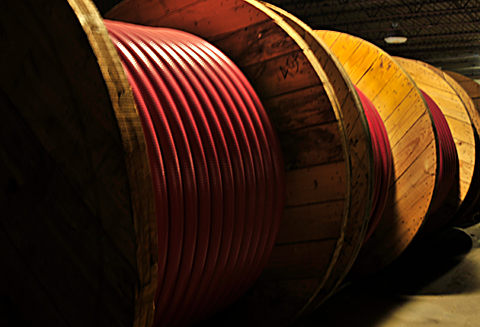A partner you can trust
Understanding the Benefits of Using Flexible Cable Conduit in Your Projects
In today's rapidly evolving construction and electrical installation landscape, the use of flexible cable conduit has emerged as a crucial element in ensuring both safety and efficiency in various projects. This versatile solution not only provides robust protection for electric cables against environmental hazards but also offers unmatched flexibility when it comes to installation.
 Whether you are undertaking a residential renovation or a large-scale industrial operation, understanding the benefits of using flexible cable conduit can enhance your project’s reliability and longevity. By exploring the various types of flexible cable conduits available and their specific applications, this blog aims to equip you with the knowledge to make informed decisions for your next electrical installation or upgrade, thereby optimizing performance and minimizing potential risks.
Whether you are undertaking a residential renovation or a large-scale industrial operation, understanding the benefits of using flexible cable conduit can enhance your project’s reliability and longevity. By exploring the various types of flexible cable conduits available and their specific applications, this blog aims to equip you with the knowledge to make informed decisions for your next electrical installation or upgrade, thereby optimizing performance and minimizing potential risks.
Benefits of Flexible Cable Conduit: Enhancing Project Safety and Durability
Flexible cable conduits are increasingly recognized for their significant benefits in enhancing project safety and durability. With the U.S. electrical conduit market projected to reach USD 1.72 billion in 2024, the demand for reliable and adaptable solutions is apparent. Particularly, the flexible metallic conduit market is anticipated to reach USD 1,163.6 million by 2035, exhibiting a robust CAGR of 7.2% between 2025 and this target year. This growth signals increased adoption of flexible conduits in various electrical installations.
When integrating flexible cable conduits into your projects, consider the following tips: ensure proper sizing to prevent excessive bending or strain on the cables, which can be crucial for maintaining performance and longevity. Additionally, selecting conduits made from high-quality materials can greatly improve the durability and safety of your installations, especially when subjected to environmental factors.
Moreover, the non-metal electrical conduit market alone crossed USD 3.8 billion in 2024, driven by innovations aimed at better safeguarding electrical systems. Utilizing flexible conduits designed for specific applications can further enhance the safety standards of your electrical projects, reducing the risk of damage and ensuring compliance with industry regulations. Embrace flexible conduit solutions to elevate both project safety and operational efficiency.
Cost-Effectiveness of Flexible Cable Conduit in Electrical Installations
 Flexible cable conduits are gaining popularity in electrical installations due to their cost-effectiveness. Unlike rigid conduits, flexible options provide a versatile solution capable of adapting to various installation environments. This flexibility not only reduces material costs but also minimizes labor expenses, as fewer fittings and supports are needed to navigate around obstacles. When budgets are tight, opting for a flexible conduit can significantly lower overall project costs without compromising safety.
Flexible cable conduits are gaining popularity in electrical installations due to their cost-effectiveness. Unlike rigid conduits, flexible options provide a versatile solution capable of adapting to various installation environments. This flexibility not only reduces material costs but also minimizes labor expenses, as fewer fittings and supports are needed to navigate around obstacles. When budgets are tight, opting for a flexible conduit can significantly lower overall project costs without compromising safety.
Moreover, the ease of installation associated with flexible conduits leads to time savings, which can also translate to financial benefits. Electricians can quickly maneuver these conduits through tight spaces and around corners, streamlining the process and reducing the duration of the installation. In a competitive market, the ability to complete projects efficiently is crucial, and using flexible cable conduit allows professionals to meet deadlines while maximizing profit margins. Ultimately, investing in flexible conduits not only optimizes project resources but also enhances the overall quality of electrical installations.
Environmental Impact: How Flexible Cable Conduits Promote Sustainability
Flexible cable conduits are gaining popularity for their significant role in promoting sustainability within various projects. These conduits are designed to protect electrical wires while offering a lightweight and adaptable alternative to traditional rigid conduit systems. One of the key environmental benefits of using flexible cable conduits is their contribution to reducing material waste during installation. Their adaptability means that fewer fittings and connections are needed, minimizing excess materials and optimizing resource use.
Moreover, flexible cable conduits are frequently made from recyclable materials, promoting a circular economy. When the conductive systems need to be replaced or upgraded, the conduits can be easily dismantled and recycled, unlike some rigid options that may contribute to landfill waste. In addition to their recyclability, many modern flexible conduits are manufactured using eco-friendly processes, which further lowers their carbon footprint. This transition towards more sustainable solutions not only benefits the environment but also marks a significant shift in how we approach project planning and execution while keeping environmental impacts top of mind.
Understanding the Benefits of Using Flexible Cable Conduit in Your Projects - Environmental Impact: How Flexible Cable Conduits Promote Sustainability
| Benefit | Description | Environmental Impact | Examples |
|---|---|---|---|
| Durability | Flexible cable conduits are resistant to abrasion, chemicals, and extreme temperatures. | Reduced waste due to longer lifespan and less frequent replacements. | Suitable for outdoor and industrial applications. |
| Flexibility | Easily bends around obstacles, allowing for versatile installation. | Less material waste during installation as fewer fittings are required. | Used in complex electrical systems and renovations. |
| Cost-Effectiveness | Lower installation costs due to reduced labor and material needs. | Promotes energy efficiency in projects by lowering overall expenses. | Applicable in residential and commercial wiring projects. |
| Resistance to Environmental Factors | Designed to withstand moisture, UV rays, and other environmental challenges. | Less frequent replacements lead to decreased landfill waste. | Ideal for coastal and high-humidity applications. |
| Safety | Provides protection for wires against physical damage and external elements. | Enhances safety standards in electrical installations, leading to lower accident rates. | Commonly used in public infrastructure and commercial buildings. |
Flexible Cable Conduit: A Solution for Complex Project Layouts and Design
 Flexible cable conduits have emerged as a valuable solution for complex project layouts and designs. Their adaptability allows for efficient routing of cables in tight spaces, around obstacles, or through irregular terrains. This flexibility not only enhances the aesthetic appeal of a project but also ensures that the cabling is secured and protected against various environmental factors, such as moisture and mechanical damage. Whether you're working on a commercial build or a residential renovation, integrating flexible cable conduit can simplify your electrical installations.
Flexible cable conduits have emerged as a valuable solution for complex project layouts and designs. Their adaptability allows for efficient routing of cables in tight spaces, around obstacles, or through irregular terrains. This flexibility not only enhances the aesthetic appeal of a project but also ensures that the cabling is secured and protected against various environmental factors, such as moisture and mechanical damage. Whether you're working on a commercial build or a residential renovation, integrating flexible cable conduit can simplify your electrical installations.
When working with flexible conduits, consider employing the following tips. First, always measure the length of the conduit required before cutting, as this can help reduce waste and ensure a neat installation. Second, utilize appropriate fittings to maintain a secure connection between conduit sections; this enhances both safety and reliability. Lastly, it's wise to plan the layout of cables within the conduit to avoid crowding, which can lead to overheating and potential hazards. By keeping these best practices in mind, you can optimize the benefits of flexible cable conduits in your projects.
Compliance and Standards: The Role of Flexible Cable Conduits in Meeting Regulations
Flexible cable conduits play a crucial role in ensuring compliance with various regulations and standards within the electrical and construction industries. According to a report by the National Electrical Manufacturers Association (NEMA), approximately 60% of electrical failures in commercial buildings can be attributed to inadequate cable management and protective measures. Flexible cable conduits, designed to safeguard wiring from environmental hazards and physical damage, contribute significantly to mitigating these risks. They not only help in adhering to regulatory codes like the National Electrical Code (NEC) but also facilitate easier installation and maintenance of electrical systems.
Moreover, the use of flexible cable conduits promotes energy efficiency and safety. A study by the International Electrotechnical Commission (IEC) emphasizes that utilizing proper conduit systems can reduce energy losses by up to 10% in industrial applications. Additionally, flexible conduits are available with various materials, such as PVC and metal, allowing for compliance with specific industry standards tailored to different environments—from hazardous locations to outdoor installations. This versatility ensures that projects can meet stringent regulations while optimizing performance and durability in a competitive landscape.
Related Posts
-

Comprehensive Guide to Selecting the Best Flexible Cable Conduit for Your Project
-

The Ultimate Guide to Choosing the Right Electric Cable for Your Projects
-

8 Essential Tips for Choosing the Best Outdoor Electrical Cable for Your Next Project
-

What is the Importance of Wire Cable in Modern Electrical Systems
-

7 Essential Factors Driving the Demand for High-Performance Trailer Cables in 2024
-

The Ultimate Guide to Sourcing the Best Wire and Cable Products for Your Business

Products
Products
LEARN MORE
Current Inventory
Current Inventory
LEARN MORE
Custom Solutions
Custom Solutions
WE CAN HELPLighting Power & Control-Signal Cable
This content is restricted to site members. If you are an existing user, please log in. New users may register … LEARN MORE “Lighting Power & Control-Signal Cable”
LOOKING
FOR HELP?
We are here to help. You can contact us or create an account online to have access to special products, technical specifications and our new online quote tool.
ELECTRO CABLES
9 Riverside Drive
P.O. Box 276
Trenton, Ontario
CANADA K8V 5R5
N.A. Toll Free: 888-ELECTRO
(1-888-353-2876)
World: 613-394-4896
Fax: 613-394-4101
Email: sale@machinecables.com
We manufacture cables that are certified by the Canadian Standards Association (CSA), listed by Underwriters Laboratories and/or listed by Intertek (ETL).
Our quality management system is registered to ISO 9001: 2015. Our team is dedicated to consistently providing quality service and products to our customers.

© 2025 ELECTRO CABLES • SITE BY SNAP 360•
